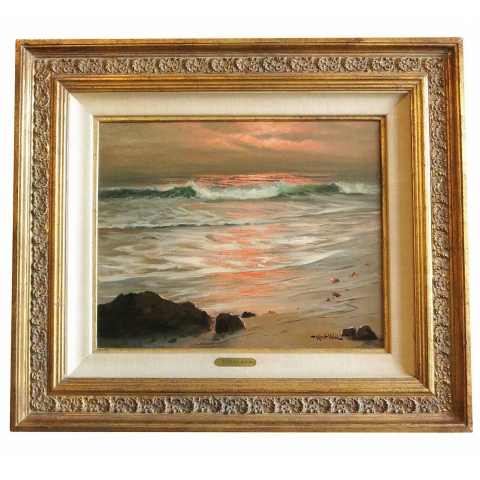
Oil on canvas landscape titled "Surf of Sunset" by Robert Wood, circa 1963. Comes in its original gallery frame.
Signed along the front by the artist, artist finger print on the back with along his personal studio stamp and the title hand-written "1963 Surf of Sunset".
Measures:
Frame- H x 26 in. W x 36.
Painting- H x 16 in. W x 19.
About the artist: Robert W. Wood was born in Sandgate, England and displayed a talent for fine art at an early age. As a young man, he studied painting in nearby Folkstone. After service in the Royal Army, Wood and a friend traveled to America. At first, Wood settled in Illinois and worked as a hired hand on a farm. He then went out on his own, living the life of a roaming painter. He traveled by hopping freight trains and selling or bartering small paintings to support himself along the way. When times were hard, he worked at whatever job was available. This was how Robert saw most of the United States and fell in love with the American countryside. By 1912, he visited Los Angeles for the first time. By the close of 1912, Wood had married Eyssel Del Wagoner in Florida. The couple moved to Ohio where their daughter, Florence, was born. During World War I, they moved to Seattle where their son, John Robert Wood, was born in 1919. In the early 1920s, the young Wood family was almost constantly on the move. They stayed for short periods in Kansas, Missouri and California. Wood's boundless travels disrupted his family life but helped him develop an appreciation for the American landscape that would inspire him for the rest of his career. Finally Wood settled down in San Antonio, Texas. San Antonio was an ideal location for the young artist because it offered a great variety of scenery to inspire a landscape painter. There Wood began to pursue painting more seriously. Wood studied with Jose Arpa (b. 1868), an academy-trained Spanish artist who was then one of San Antonio's best-known painters. In a short time, Wood had established a reputation for well-painted landscapes in central Texas. In 1925, Wood and Eyssel divorced. During his time in Texas, Wood was very productive. He made sketching trips to the Rocky Mountains, the Grand Tetons, the Cascades, Yellowstone, and the High Sierras. Wood shipped his paintings to dealers and began to build a reputation with collectors across the country. In San Antonio he met and married his second wife, Tula. After 17 years in Texas, Wood was ready to move again and found himself in the town of Laguna Beach, California. In Laguna, he was recognized for his landscapes and marine paintings. For the rest of his career, Wood's paintings of the California coast remained a significant part of his repertoire. Living in Laguna for seven years, Robert became an active member of the Laguna Art Association and an exhibitor at the annual Laguna Festival of the Arts. Looking for a change in seasons, Wood moved east to the art colony of Woodstock, New York. In Woodstock, Wood painted high-key fall scenes. His landscapes of Woodstock were soon sought after by print companies and reproduced in large quantities. After a few years in New York, Robert and Tula moved back to Laguna Beach. Robert and Tula became more and more estranged and divorced in 1952. The following year, Wood was in a near fatal car accident on the Pacific Coast Highway. An amateur female artist by the name of Caryl helped him around the house during his recovery and the two married shortly after. During the 1950s, Wood's works became increasingly popular in print and the royalties eventually made him a comfortable living. Through frequent exhibitions and steady print sales Wood's notoriety increased and he found it difficult to keep up with the demand for his original works. In the early 1960s, Robert and Caryl Wood moved to Bishop, at the foot of California's rugged Sierras. Through the 1960s, Wood's fame grew and his paintings brought higher prices. At the age of 80, the American Express Company commissioned him to paint a series of six works to be reproduced as limited edition serigraphs for their cardholders. Each print depicted one of the National Parks, subjects that were well known to Wood. A few years later, Wood moved to San Diego. After several years there, the Woods made their final move, back to Bishop and the Sierras. Robert Wood continued to paint until shortly before his death in the spring of 1979, just a few weeks before his 90th birthday.





